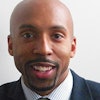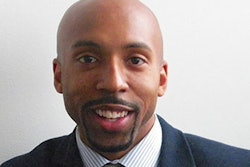The cautionary advice dispatched by his mentors when Dr. José Vargas-Muñiz was a college student dented his confidence and, on several occasions, tripped him up.
Don’t let your hands fly the way so many Puerto Ricans like you do when they’re excited about something.
In a professional setting, tell no one that you’re queer.
Try to lose your island-inflected speech, they’d suggested.
 Dr. José Vargas-Muñiz
Dr. José Vargas-Muñiz
What confirmed that his mentors — Latino college advisors, speaking from the pain of personal experience — had given him some bad advice were the happenings he witnessed in 2010 at the Society for Advancement of Chicanos/Hispanics & Native Americans in Science (SACNAS) conference.
“They brought performers that were honoring Hispanic music,” Vargas-Muñiz said of that gathering in California. “On the first day, they opened with a blessing by an Indigenous person from that area, from a group whose native land we were meeting on … One of the keynote speakers even welcomed everyone in Spanish.
“It was empowering,” he said. “They were interweaving cultural identity with the journeys people were on.”
As it celebrates its 50th anniversary, SACNAS remains rooted in a belief that science cannot be properly taught, researched, or applied to human beings’ daily existence unless scientists bring some essential parts of their background and worldview to that sphere.
“You can either look at that as something that needs to be overcome, or you can look at that as shaping very unique perspectives in ways that are going to have a really unique effect on the science [that individuals] end up doing,” said Dr. Charla Lambert, president of SACNAS and Cold Spring Harbor Laboratory’s diversity, equity and inclusion officer.
“SACNAS has always come at it as strength-based rather than deficit minded,” Lambert continued. “So, we're going to create this environment that includes aspects of your culture. It's going to recognize aspects of your upbringing, maybe aspects of your family life that not everybody in STEM training programs or STEM careers have to deal with. You can do all of that here and be a whole person.”
Granting that sort of leeway to aspiring and professional scientists from underrepresented groups has only increased during the five decades that SACNAS has been operating and growing. During its inaugural year, 1973, there were roughly 50 SACNAS conferees, Lambert said. Co-founder Dr. Richard Tapia said 15 people, in 1971, began brainstorming about the organization they eventually launched. Last year, when the society’s yearly meeting was in Puerto Rico, about 9,000 people were on hand, including many of the 6,000 who actually are on SACNAS’ membership roster.
A number of them mentor budding scientists of color at a time when the scientific sphere remains overwhelmingly white and male. That, critics contend, limits how well science serves a nation where females are 50.1% of the population and non-Hispanic whites 59.7% of the population. While whites, overall, are 75.8% of the population, they are projected to be the nation’s minority by 2044.
SACNAS’ birth coincided with the Black Power and Chicano Power Movements, said Tapia, whose honors include a National Medal of Science. He directs the Tapia Center for Excellence and Equity at Rice University, where he has taught, among other subjects, engineering and computational applied mathematics and operations research.
“We started something that I needed so much,” the 85-year-old said. “There was a hole in my heart, and I didn’t know what it was. SACNAS filled that hole. And it wasn’t that we were fighting society or academia. It’s that we were a group people who were similarly situated … the Chicano Movement gave us identity. SACNAS gave us community.”
He lauds the group’s growth and its programming. But he regrets that more Research 1 institutions, such as Harvard, Princeton, Rice and Stanford, aren’t more heavily involved in SACNAS and that the number of hard science researchers has declined over the years, while those in the soft sciences has risen.
“People may call that elitist. But I’m not elitist …. We need to be well distributed across all the universities,” said Tapia, who critiques the need in his 2022 book, “Losing the Precious Few: How American Fails to Educate Its Minorities in Science and Engineering.”
In the STEM workforce, according to the National Center for Science and Engineering Statistics’ 2023 “Diversity and STEM: Women, Minorities and Persons with Disabilities” report, 24% of scientists and engineers were Hispanic, Black, American Indian or Alaska Native, combined, in 2021. In 2018, according to 2021 version of that bi-annual analysis, 16.8% of all scientists and engineers employed full-time and16.7% of those employed part-time were from those same minority groups.
SACNAS has been engaging in conversations and tackling topics as part of its efforts to boost the tally of STEM workers who are Native or Hispanic. Panels at its annual conference reflect the society’s broader initiatives. They’ve included such topics as “Being Your Authentic Self in Grad School: Community, Advocacy, and Resilience”; “Creating Citizen Science and Community-Engaged Outreach with Rural and Indigenous Populations”; “Effects of Climate Change on Pacific Islands, their Indigenous Peoples, and Resources”; “Engaging in Transdisciplinary and Community-Engaged Research to Reduce Health Disparities in Our Communities”; and “Pacific Islanders in Mathematics.”
Those conference panels, as well as everything else that SACNAS does, are critical, said Dr. LeManuel “Lee” Bitsóí, a bioethics and critical ethnography researcher who also is Brandeis University’s vice president for diversity, equity and inclusion.
Among matters now on his and SACNAS’ radar is what many expect will be the U.S. Supreme Court’s banning of affirmative action plans, a ruling expected this summer. “How is that going to impact missions?” asks SACNAS Vice President Bitsóí, born and reared on New Mexico’s Navajo Reservation. “How is it going to impact financial aid, endowed scholarships that have been based on race and ethnicity?
“And how will it impact organizations like SACNAS? Are we no longer going to have a voice? I don't think that will be the case. But are there ways in which future legislation could come into play to thwart some of our efforts?”
Derailing those programs would be a setback and not just for SACNAS and organizations akin to it.
“One of the things that's changed [since SACNAS’ inception] is the idea that there really are systemic factors that are creating barriers for Indigenous scientists and for Hispanic scientists, whether their family has been in the U.S. for a long time, or whether they're recent immigrants,” said geneticist Lambert, the daughter of an Indigenous Alaskan mother and a Louisiana Cajun father,
“Diversity improves the creativity and the innovation … That’s become more of an accepted and recognized piece of wisdom,” continues Lambert, whose National Institutes of Health-funded research has included investigating the impact of scientific training, mentoring, outreach and community building on STEM.
It’s a good thing that many institutions have been tackling those systemic barriers, said Southern Illinois University’s Vargas-Muñiz, who, in 2013 and 2014, was a student member of SACNAS’ board of directors. Removing those barriers also erodes the kind of isolation and imposter syndrome he often felt during college and, perhaps, even as a newly launched, full-fledged researcher, earning a Ph.D. from Duke University in 2017.
“I remember going to grad school interviews with these thoughts of, ‘Make sure you don’t come off as queer. Make sure you try to mimic white culture.’ It backfired. An interviewer told me I came off as uninterested and unapproachable,” said Vargas-Muñiz , a researcher of fungal biology.
He hopes his lab work will lead, for example, to treatments for asthma, which disproportionately affects Black and Hispanic people, and for a type of yeast infection that increasingly is attacking nursing home residents.
“When you don’t often see people like you coming into science, it is easy to fall into that idea that, ‘Oh, I’m going to make it? But when I go to SACNAS events, it recharges my battery,” said Vargas- Muñiz. “That way, I can be myself and remind myself of who I am.”















